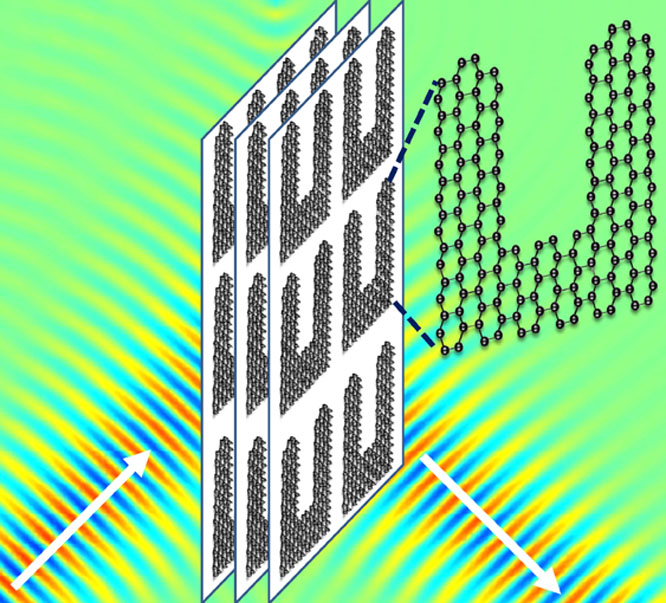Aug. 9 2013
Could graphene – a one-layer thick sheet of carbon atoms – be the ingredient needed for super-efficient solar harvesting with metamaterials? Or for “light on wire” plasmonic data transmission? In the Aug. 9 issue of Science, U.S. Department of Energy’s Ames Laboratory physicists discuss the potential and challenges of using graphene in metamaterials and plasmonics in terahertz applications, which operate at frequencies between microwave and infrared waves.
Metamaterials are man-made structures that exhibit properties not possible in natural materials, such as refracting light “backward” or absorbing all the light that hits them. Soukoulis and fellow Ames Laboratory physicists Philippe Tassin and Thomas Koschny found that graphene may be a good candidate to replace the metals currently used to build metamaterials.
“Graphene is a fascinating and promising material because it’s so thin, is very electronically responsive, and has electronic properties that are easily changed,” said Costas Soukoulis, Ames Laboratory physicist and Iowa State University Distinguished Professor of physics and astronomy. “Our review of the findings shows hurdles to cross before graphene could replace the thin metal films currently used in metamaterials and plasmonics.”
“Graphene offers an advantage over metals because graphene’s properties can be more readily tuned to obtain the electrical response desired for a given application,” said Soukoulis.
Graphene’s tunability may also make it a good candidate for use in plasmonics, where a tiny structure uses light to carry information.
However, Soukoulis, Tassin and Koschny still see challenges. They surveyed both experimental measurements and theoretical simulations about graphene’s properties relevant for terahertz applications. In general, Soukoulis’ team noted that the data indicate a “discrepancy between the experimentally realizable and the theoretically predicted performance.” For instance, experimental data have shown significantly higher electrical losses than has been estimated by theoretical work.
“Overcoming those dissipative losses will be the major obstacle for using graphene in terahertz applications of metamaterials and plasmonics,” said Soukoulis.
Soukoulis, Tassin and Koschny’s work at Ames Laboratory was supported by the U.S. Department of Energy’s Office of Science (funding for the search for better optical materials, properties of metals at optical frequencies, and understanding electrical losses in metamaterials) and the U.S. Office of Naval Research (graphene as conductors for resonant metamaterials). Iowa State University College of Liberal Arts Frances M. Craig Professorship also supports Soukoulis’ efforts.
DOE’s Office of Science is the single largest supporter of basic research in the physical sciences in the United States, and is working to address some of the most pressing challenges of our time. For more information, please visit the Office of Science website at science.energy.gov/.
Ames Laboratory is a U.S. Department of Energy Office of Science national laboratory operated by Iowa State University. Ames Laboratory creates innovative materials, technologies and energy solutions. We use our expertise, unique capabilities and interdisciplinary collaborations to solve global problems.













